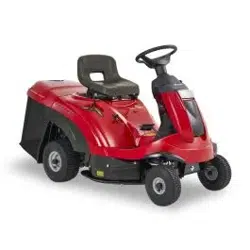Loading ...
Loading ...
Loading ...

2
tion of the brake. The main reasons for loss of
control are:
• Excessive speed;
• Type of machine unsuitable for its task;
conditions, especially slopes;
• Incorrect use as a towing machine.
9) The machine is supplied with a series of
micro-switches and safety devices which must
never be tampered with or removed; this will
invalidate the warranty and relieve the manufac-
turer from all responsibility. Always check that
the safety devices are working properly before
using the machine.
B) PRELIMINARY OPERATIONS
1) While using the machine, always wear anti-
slip and resistant work footwear and long pants.
Do not operate the machine when barefoot or
wearing open sandals. Avoid wearing chains,
hanging cords or ties. Tie hair back if it is long.
Always wear protective earplugs.
2) Thoroughly inspect the entire work area and
remove anything that could be thrown by the
machine or damage the cutting-means as-
sembly or engine (stones, branches, iron wire,
bones, etc.).
-
mable.
– Store the fuel in special containers;
– add fuel, using a funnel, only outdoors; do not
smoke during this operation and each time
fuel is handled;
– Top-up with fuel before igniting the engine;
never remove the tank cap or add fuel while
the engine is running or when it is hot;
– if you have spilled some fuel, do not attempt
to ignite the engine but move the machine
away from the area of spillage and avoid cre-
ating any source of ignition until the fuel has
evaporated and fuel vapours have dissipated:
– Always put the tank and fuel container caps
back on and tighten well;
5) Before using the machine, check its general
condition and in particular:
the appearance of the cutting means, and check
that the screws and cutting-means assembly
are not worn or damaged. Replace the entire
cutting means and all damaged or worn screws
to preserve balance. Any repairs must be done
at a specialised centre.
6) Check the battery status regularly, and re-
place it if there is any damage to the casing,
cover or terminals.
guards (grass catcher, side discharge guard or
rear discharge guard).
C) DURING USE
where dangerous carbon monoxide fumes can
develop. All ignition operations have to be ef-
fected in an open or well-ventilated area. Always
remember that exhaust fumes are toxic.
light in good visibility conditions. Keep persons,
children and animals away from the working
area.
3) If possible, avoid mowing wet grass. Avoid
working in the rain and when there is a risk of
a thunderstorm risk. Do not use the machine in
bad weather conditions, especially when there
is risk of lightening.
blade, shift the gear lever (for mechanical trans-
mission) or the speed change lever (for hydro-
static transmission) into neutral and engage the
parking brake.
5) Pay special attention when approaching ob-
stacles that could compromise visibility.
6) Engage the parking brake when parking the
machine.
7) The machine must not be used on slopes of
over 10° (17%), regardless of the mowing direc-
tion.
8) Remember there is no such thing as a “safe”
-
lar care. To prevent overturning or loss of control
over the machine:
– Do not stop or start suddenly when going up
or downhill;
– Engage clutch slowly, always keep the ma-
chine in gear (for mechanical transmission) or
engage the speed change lever slowly both
for forward and reverse movement (for hydro-
static transmission), especially when travel-
ling downhill;
– Machine speeds should be kept low on slopes
and during tight turns;
– Watch out for humps, hollows and other hidden
hazards;
– Never mow across the face of the slope.
Lawns on a slope have to be mowed moving
up and down and never across them. When
changing direction, take great care that the
wheels facing the slope do not hit any obsta-
cles (such as stones, branches, roots, etc.)
that may cause the machine to slide side-
ways, tip over or make you lose control.
Reduce speed before any change of direction
on slopes, and always apply the parking brake
before leaving the machine at a standstill and
unattended.
10) Be very careful near ravines, ditches or
Loading ...
Loading ...
Loading ...
